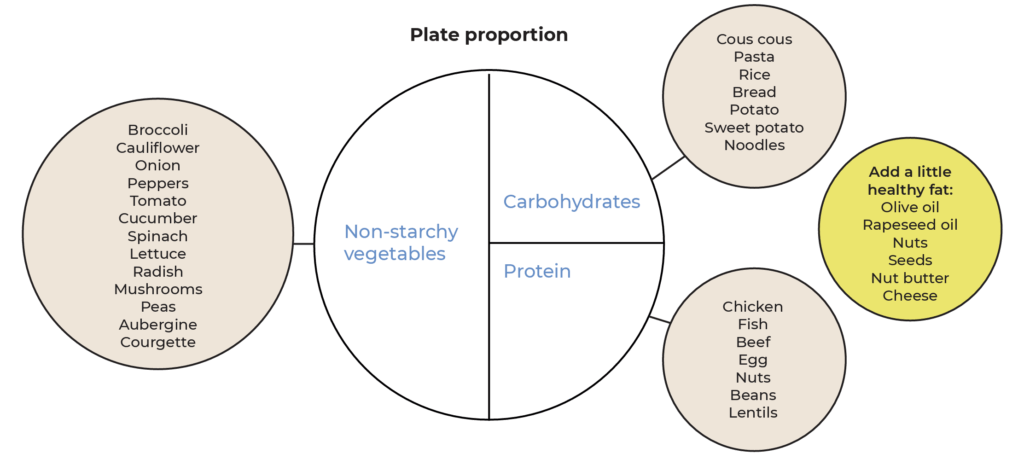Things to consider if you’re not losing weight
Starting your weight loss journey is exciting, but we get that sometimes the progress feels slower than expected. To help the weight loss injection work its magic, it’s super important to pair it with a healthy, calorie-controlled diet. Stick with it, and you’ll start seeing the results.
Also, when it comes to losing weight, we often imagine cutting back on food, feeling hungry all the time, and missing out on our favourite treats. But here’s the good news – by choosing foods with a lower energy density, you can reduce your calorie intake while still enjoying plenty of satisfying meals. It’s all about making choices that satisfy your appetite.
What is energy density?
Energy density is the number of calories per gram of food. Foods lower in energy density provide less energy per gram, which means we can eat more of them while consuming fewer calories compared to foods with a higher energy.
How to be more calorie aware
It’s useful to understand the energy density of specific nutrients:
Calories per gram:
- Carbohydrate: 4
- Fats: 9
- Protein: 4
- Alcohol: 7
Each nutrient has a different energy density, by altering what we have, we can affect the total calorie intake. You don’t need to count every single calorie you eat, but being calorie-aware can make a big difference! Knowing which foods are higher or lower in energy density can really help on your weight loss journey. There are plenty of handy apps and guides to make it easier, plus checking food labels regularly is a great way to understand what’s in your food.
Foods which are filling
Foods which are lower in energy density include those which are naturally high in water such as fruits and vegetables: oranges, apples, berries, broccoli, spinach, tomatoes, cucumber, onions, peppers, aubergine, courgettes. Also vegetable based soups, stews and casseroles.
Fibre containing foods
Fibre bulks up food but can’t be fully digested. It helps us to feel full as it slows the rate at which we digest foods. Foods rich in fibre include fruits and vegetables, wholegrains (cereal/pasta/bread), oats, barley, beans, lentils and pulses.
Low fat foods
By reducing the amount of fat we eat or add to our meals, the total energy density can be reduced. As fat is the most energy dense nutrient, if we are using less it may lead to a reasonable energy saving. Easy ways to reduce fat content:
- Leaner cuts of meat/removing visible fat
- Use less oil when cooking
- Spread less butter/margarine on bread/toast
- Avoid ultra processed foods which are high in fat e.g. chocolate, cake, pizza, fried chicken
- Switch to lower fat versions e.g. change mayonnaise to low fat version
High protein foods
Foods rich in protein can decrease hunger and help us to feel full. Fish, lean meat/poultry, eggs, tofu, soya mince, beans and pulses are all foods which contain good levels of protein.
Examples of high energy dense foods and lower alternatives.
- 1 tbsp of raisins (30g) (82 calories) – swap for – a bowl (130g) of chopped melon (40 calories)
- Chocolate brownie (82g) (362 calories) – swap for – large banana (190g with skin) (122 calories)
- A medium bowl of crunchy nut flakes (40g) with full fat milk (270 calories) – swap for – 2 Weetabix with skimmed milk topped with a portion of strawberries (200 calories)
- Shop bought triple cheese sandwich (600 calories) – swap for – 2 slices of wholegrain toast and ½ tin of baked beans (400 calories)
- Pepperoni pizza (350g) (1000 calories) – swap for – 1 large chicken breast (200g), 1 medium sized jacket potato (220g) with 10g butter and side salad (600 calories)
- 500ml energy drink (237 calories) – swap for – 500ml zero cola (2 calories)
How to set out your plate when eating a meal

- Fill half your plate with non-starchy vegetables
- Aim for a quarter of your plate to be lean protein
- Aim for a quarter of your plate be wholegrain starchy carbohydrates
- It’s ok to add a little healthy fat to your plate, this can help keep us feeling fuller for longer, but keep the amount small, e.g. a drizzle of olive oil or thumb size amount of peanut butter
Top tips for lowering energy density
- Choose lean cuts of meat, trim off any excess fat, remove skin from poultry.
- Avoid adding too much fat during cooking.
- Add plenty of lower energy dense foods to a meal e.g. have a side salad with a smaller portion of lasagna or add lots of chopped veg into your bolognaise.
- Opt for higher fibre starchy carbohydrates e.g. wholemeal pasta or rice.
- If you drink alcohol, do so in moderation.
- Avoid high sugar drinks, switch to diet or zero versions. Water is the best form of hydration.
- Limit pudding. If you do have, keep the portion small and infrequent.
- Avoid biscuits, chocolate, crisps, and sweets or enjoy less often. If you find yourself snacking on these foods often ask yourself if this is out of hunger or habit. Often, we eat when we are not hungry and such foods can quickly add calories, e.g. 6 digestive biscuits equal 500 kcals. If you do feel hungry between meals and need to snack, consider healthier alternatives, e.g. 2 wholegrain crackers with 30 grams of cheese, 30g unsalted nuts, 1 boiled egg, small handful of fruit.
- A great way to understand your food choices and behaviours is to keep a food diary. Capturing what you eat on paper or via an app can help you make decisions around what changes you would like to make and also helps you keep track.
Information adapted from: bda.uk
CLI5199FEB25